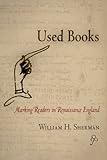Used Books : Marking Readers in Renaissance England / William H. Sherman.
Material type: TextSeries: Material TextsPublisher: Philadelphia : University of Pennsylvania Press, [2010]Copyright date: ©2008Description: 1 online resource (288 p.) : 36 illusContent type:
TextSeries: Material TextsPublisher: Philadelphia : University of Pennsylvania Press, [2010]Copyright date: ©2008Description: 1 online resource (288 p.) : 36 illusContent type: - 9780812220841
- 9780812203448
- 028.9094209031
- Z1003.5.G7 S54 2009
- online - DeGruyter
| Item type | Current library | Call number | URL | Status | Notes | Barcode | |
|---|---|---|---|---|---|---|---|
 eBook
eBook
|
Biblioteca "Angelicum" Pont. Univ. S.Tommaso d'Aquino Nuvola online | online - DeGruyter (Browse shelf(Opens below)) | Online access | Not for loan (Accesso limitato) | Accesso per gli utenti autorizzati / Access for authorized users | (dgr)9780812203448 |
Frontmatter -- Contents -- Illustrations -- Preface -- Part I. Of Marks and Methods -- Chapter 1. Introduction: Used Books -- Chapter 2. Toward a History of the Manicule -- Chapter 3. Reading the Matriarchive -- Part II. Reading and Religion -- Chapter 4. ‘‘The Book thus put in every vulgar hand’’: Marking the Bible -- Chapter 5. An Uncommon Book of Common Prayer -- Part III. Remarkable Readers -- Chapter 6. John Dee’s Columbian Encounter -- Chapter 7. Sir Julius Caesar’s Search Engine -- Part IV. Renaissance Readers and Modern Collectors -- Chapter 8. Dirty Books? Attitudes Toward Readers’ Marks -- Afterword. The Future of Past Readers -- Notes -- Bibliography -- Index -- Acknowledgments
restricted access online access with authorization star
http://purl.org/coar/access_right/c_16ec
In a recent sale catalog, one bookseller apologized for the condition of a sixteenth-century volume as "rather soiled by use." When the book was displayed the next year, the exhibition catalogue described it as "well and piously used [with] marginal notations in an Elizabethan hand [that] bring to life an early and earnest owner"; and the book's buyer, for his part, considered it to be "enlivened by the marginal notes and comments." For this collector, as for an increasing number of cultural historians and historians of the book, a marked-up copy was more interesting than one in pristine condition.William H. Sherman recovers a culture that took the phrase "mark my words" quite literally. Books from the first two centuries of printing are full of marginalia and other signs of engagement and use, such as customized bindings, traces of food and drink, penmanship exercises, and doodles. These marks offer a vast archive of information about the lives of books and their place in the lives of their readers.Based on a survey of thousands of early printed books, Used Books describes what readers wrote in and around their books and what we can learn from these marks by using the tools of archaeologists as well as historians and literary critics. The chapters address the place of book-marking in schools and churches, the use of the "manicule" (the ubiquitous hand-with-pointing-finger symbol), the role played by women in information management, the extraordinary commonplace book used for nearly sixty years by Renaissance England's greatest lawyer-statesman, and the attitudes toward annotated books among collectors and librarians from the Middle Ages to the present.This wide-ranging, learned, and often surprising book will make the marks of Renaissance readers more visible and legible to scholars, collectors, and bibliophiles.
Mode of access: Internet via World Wide Web.
In English.
Description based on online resource; title from PDF title page (publisher's Web site, viewed 08. Aug 2023)


